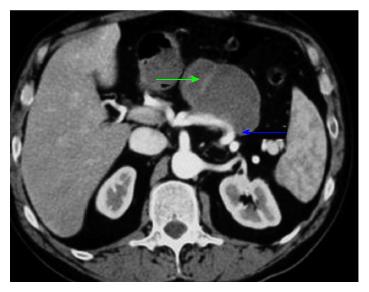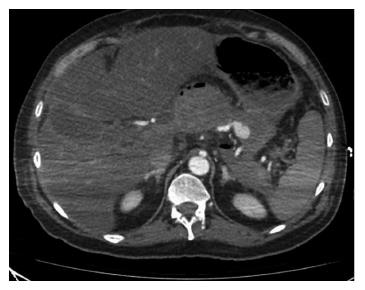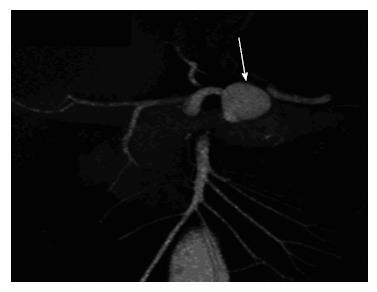Copyright
©The Author(s) 2017.
World J Gastroenterol. Aug 14, 2017; 23(30): 5460-5468
Published online Aug 14, 2017. doi: 10.3748/wjg.v23.i30.5460
Published online Aug 14, 2017. doi: 10.3748/wjg.v23.i30.5460
Figure 1 Computed tomography arterial and venous phase showing a pseudocyst (green arrows) eroding the splenic artery (blue arrows)[90].
Figure 2 Computed tomography arterial and venous phases showing a pseudoaneurysm in a patient with necrotizing pancreatitis.
Figure 3 Three-D coronal maximum-intensity-projection computed tomography image in a 45-year-old man who had remote history of pancreatitis presented with back pain showing 2.
0-cm pseudoaneurysm (arrow) arising from splenic artery[91].
Figure 4 Splenic artery pseudoaneurysm before and after embolization.
A: Post contrast computed tomography scan showing the pseudoaneurysm rising from the splenic artery; B: Pre embolization selective splenic arterial DSA angiography image showing pseudoaneurysm; C: Post embolization DSA image showing the coils inside the splenic artery with its resultant embolization[92].
- Citation: Evans RP, Mourad MM, Pall G, Fisher SG, Bramhall SR. Pancreatitis: Preventing catastrophic haemorrhage. World J Gastroenterol 2017; 23(30): 5460-5468
- URL: https://www.wjgnet.com/1007-9327/full/v23/i30/5460.htm
- DOI: https://dx.doi.org/10.3748/wjg.v23.i30.5460
















